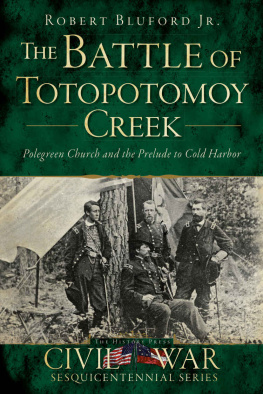Keith S. Bohannon - Cold Harbor to the Crater : the end of the Overland Campaign
Here you can read online Keith S. Bohannon - Cold Harbor to the Crater : the end of the Overland Campaign full text of the book (entire story) in english for free. Download pdf and epub, get meaning, cover and reviews about this ebook. City: Chapel Hill, North Carolina, year: 2015, publisher: The University of North Carolina Press, genre: Politics. Description of the work, (preface) as well as reviews are available. Best literature library LitArk.com created for fans of good reading and offers a wide selection of genres:
Romance novel
Science fiction
Adventure
Detective
Science
History
Home and family
Prose
Art
Politics
Computer
Non-fiction
Religion
Business
Children
Humor
Choose a favorite category and find really read worthwhile books. Enjoy immersion in the world of imagination, feel the emotions of the characters or learn something new for yourself, make an fascinating discovery.

- Book:Cold Harbor to the Crater : the end of the Overland Campaign
- Author:
- Publisher:The University of North Carolina Press
- Genre:
- Year:2015
- City:Chapel Hill, North Carolina
- Rating:5 / 5
- Favourites:Add to favourites
- Your mark:
- 100
- 1
- 2
- 3
- 4
- 5
Cold Harbor to the Crater : the end of the Overland Campaign: summary, description and annotation
We offer to read an annotation, description, summary or preface (depends on what the author of the book "Cold Harbor to the Crater : the end of the Overland Campaign" wrote himself). If you haven't found the necessary information about the book — write in the comments, we will try to find it.
Cold Harbor to the Crater : the end of the Overland Campaign — read online for free the complete book (whole text) full work
Below is the text of the book, divided by pages. System saving the place of the last page read, allows you to conveniently read the book "Cold Harbor to the Crater : the end of the Overland Campaign" online for free, without having to search again every time where you left off. Put a bookmark, and you can go to the page where you finished reading at any time.
Font size:
Interval:
Bookmark:

from Catherine Lawrence and Eric Papenfuse.
All rights reserved
Designed and set in Miller by Rebecca Evans
Manufactured in the United States of America
and durability of the Committee on Production Guidelines for
Book Longevity of the Council on Library Resources.
of the Green Press Initiative since 2003.
to Richmond! Harpers Weekly, June 18, 1864 (Library of Congress,
Ben and Beatrice Goldstein Foundation Collection)
Cold Harbor to the Crater : the end of the Overland Campaign/
edited by Gary W. Gallagher and Caroline E. Janney.
pages cm. (Military campaigns of the Civil War)
Includes bibliographical references and index.
ISBN 978-1-4696-2533-1 (cloth : alk. paper)
ISBN 978-1-4696-2534-8 (ebook)
1. Overland Campaign, Va., 1864. 2. Cold Harbor, Battle of, Va., 1864.
3. Petersburg Crater, Battle of, Va., 1864. 4. Petersburg (Va.)History
Siege, 18641865. 5. United StatesHistoryCivil War, 18611865
Campaigns. I. Gallagher, Gary W. II. Janney, Caroline E.
E 476.52. C 65 2015 973.736dc23
2015010513
Font size:
Interval:
Bookmark:
Similar books «Cold Harbor to the Crater : the end of the Overland Campaign»
Look at similar books to Cold Harbor to the Crater : the end of the Overland Campaign. We have selected literature similar in name and meaning in the hope of providing readers with more options to find new, interesting, not yet read works.
Discussion, reviews of the book Cold Harbor to the Crater : the end of the Overland Campaign and just readers' own opinions. Leave your comments, write what you think about the work, its meaning or the main characters. Specify what exactly you liked and what you didn't like, and why you think so.






